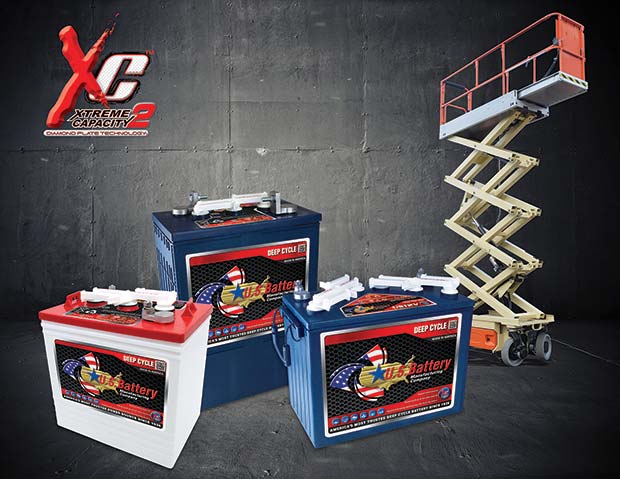As the country’s leading independent distributor of industrial batteries and related power storage equipment, Manbat Industrial is able to supply the most appropriate individual elements to ensure the suitability of the overall package. In addition, it has the largest number of service engineers and therefore is the only company to be able to provide a truly national service encompassing general battery advice, as well as sales and service support.

Manbat Industrial is also the country’s sole distributor for the worlds leading manufacturer of deep cycle batteries – U.S. Battery Manufacturing Company. U.S.
Battery’s prolific range includes 2, 6, 8 and 12-volt lead acid batteries, as well as AGM batteries and watering systems.
The majority of the batteries in the lead-acid range incorporate its unique Diamond Plate Technology® – which it denotes with the Xtreme Capacity (XC2™) label – to provide those using high energy drawing equipment such as cranes, lifts and access machines with the ideal battery solution as they combine higher initial capacity and greater total energy delivery.
U.S. Battery’s Diamond Plate Technology® has made it possible for the company to produce a uniformly fine crystal structure throughout the battery’s plate formulation, through the introduction of a synthetic tetrabasic lead sulphate (TTBLS) additive. The net result is enhanced battery performance and charging characteristics, which prolongs the life of the battery. Prior to the introduction of synthetic TTBLS additives, the plate production process required a high temperature, high humidity curing process.
Even though this curing process was well controlled and produced consistently high levels of TTBLS, it was not well suited for controlling the size of the individual crystals that were ‘grown’ in the crystal development process. The resulting crystals therefore varied widely and if they grew too large, the plates would become difficult to form. This ultimately affects the battery’s performance, returning a lower capacity and less efficient charge characteristics.
XC2™ batteries therefore delivery increased initial capacity, higher peak capacity, enhanced rechargeability, improved vibration and shock resistance. The batteries also gain improved energy density and specific energy without any increase in their size or weight.
In Practice
As Fred Wehmeyer, senior VP engineering for U.S. Battery Manufacturing explains, this development in battery technology allows companies operating a fleet of lifts/aerial platforms to lower their annual operating costs.
“The XC2™ formulation, used in conjunction with our Diamond Plate Technology® is our proprietary batteryplate combination that dramatically extends the cycle-life and total amp-hour operation in deep-cycle batteries.
“These deep-cycle batteries can reach peak capacity in as few as 25 cycles. In addition, the battery’s initial and peak capacity are dramatically increased, and its higher total energy delivery will allow fleets to save time and money.”
In order to determine any cost savings, the fleet owner or manager must first make scheduled maintenance checks and take detailed notes on the condition of the batteries. “Anyone in charge of maintaining a fleet of machines needs to look at their battery expenditures in terms of cost-per-cycle, and cost-per-amp hours delivered over the life of the battery,” says Wehmeyer. “Simply comparing battery ratings on the label or published cycle life, doesn’t always tell the true story. In addition, purchasing the least expensive batteries you can find, almost never adds up to a cost saving in the long run.”
In order to determine the cost-per-cycle and cost-peramp- hours delivered, Wehmeyer suggests measuring the condition of the batteries on a weekly basis and making a note of the total service hours achieved from a full charge (total amp-hours).
He also suggests recording the number of cycles, before they are no longer useful.
Over the course of several months, the information gathered will show an average run-time and amp-hours delivered from the batteries.
This allows for a proper comparison of battery performance against the purchase cost. “Once you compare the actual operating cost-per-amp-hour, you can begin to see that not all deepcycle batteries are the same, and those that are more efficient, even at a higher initial purchase price, can actually save overall operational costs in the long run,”‘ says Wehmeyer.
For comparison, a U.S. Battery with XC2™ was tested against a popular brand. The results showed that the XC2™ battery delivered a 36 per cent longer cycle-life and 55 per cent more total amp-hours over its cycle life than the nearest competitor.
If the purchase prices for the batteries are the same, this example translates to a 27 per cent reduction in cost-percycle and a 65 per cent reduction in cost-per-amp hour over the life of the battery.
Tel: 01743 218500




Comments are closed.